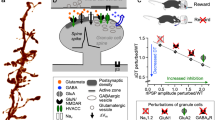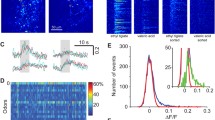Abstract
The external plexiform layer is where theinteractions between the mitral (excitatory) and granule (inhibitory)cells of the olfactory bulb (OB) take place. Two outstanding features ofthese interactions are that they aredendrodendritic and that there seem to be nonebetween excitatory cells. The latter are usually credited with the role of forming Hebbian cell assemblies.Hence, it would seem that this structure lacks the necessaryingredients for an associative memory system.In this article we show that in spite of these two properties thissystem can serve as an associative memory. Our model incorporates theessential anatomical characteristics of the OB. The memories in oursystem, defined by Hebbian mitral assemblies, are activated viathe interactions with the inhibitory granule cells. The nonlinearityis introduced in our model via a sigmoid function that describesneurotransmitter release in reciprocal dendrodendritic synapses. Thecapacity (maximal number of odors that can be memorized) depends onthe sparseness of coding that is being used. For very low memoryactivities, the capacity grows as a fractional power of the number ofneurons. We validate the theoretical results by numericalsimulations. An interesting result of our model is that its capacityincreases as a function of the ratio of inhibitory to excitatorypopulations. This may provide an explanation for the dominance ofinhibitory cells in the olfactory bulb.
Similar content being viewed by others
References
Agmon-Snir H, Segev I (1993) Signal delay and input synchronization in passive dendritic structures. J. of Neurophysiol. 70(5): 2066–2085.
Davis JL, Eichenbaum H (eds.) (1991) Olfaction. MIT Press, Cambridge, MA.
Erdi P, Grobler T, Barna G, Kaski K (1993) Dynamics of the olfactory bulb: Bifurcations, learning, and memory. Biol. Cybern.69:57–66.
Farbman AL (1991) Development neurobiology of the olfactory system. In: Getchel TV, Doty RL, Batoshuk LM, and Snow JB, eds. Smell and Taste in Health and Disease. Raven Press, New York, pp. 19–33.
Fort JC, Rospars JP (1992) Modelling of the qualitative discrimination of odours in the first two layers of olfactory system by Jutten and Herault algorithm. Comptes Rendus de l’Academie des Sciences.Serie III, Sciences de la Vie, 315(9):331–336.
Frolov A, Muraviev I (1988) Informational Characteristics of Neural Networks. Nauka. Moscow. (In Russian).
Gardner E (1987) Maximum storage capacity in neural networks. Europhys. Lett.4(4):481–485.
Hasselmo ME (1993) Acetylcholine and learning in a cortical associative memory. Neural Computation5(1), 32–44.
Hasselmo ME, Bower JM (1993) Acetylcholine and memory. Trends in Neurosciences16(6):218–222.
Hendin O, Horn D, Hopfield JJ (1994) Decomposition of a mixture of signals in a model of the olfactory bulb. Proc. Natl. Acad. Sci. 91(13):5942–5946.
Hendin O, Horn D, Tsodyks MV (1996) Associative memory and segmentation in an oscillatory neural model of the olfactory bulb. Preprint, Tel Aviv University.
Hopfield JJ (1982) Neural networks and physical systems with emergent collective computational abilities. Proc. Natl. Acad. Sci. USA 79:2554–2558.
Hopfield JJ (1984) Neurons with graded response have collective computational properties like those of two-state neurons. Proc. Natl. Acad. Sci. USA81:3088–3092.
Hopfield JJ (1991) Olfactory computation and object perception. Proc. Natl. Acad. Sci. USA: 6462–6466.
Jahr CE, Nicoll RA (1982) An intracellular analysis of dendrodendritic inhibition in the turtle in vitro olfactory bulb. J. Physiol. (London) 326:213–234.
Laurent G, Davidowitz H (1994) Encoding of olfactory information with oscillating neural assemblies. Science265:1872–1875.
Li Z, Hopfield JJ (1989) Modeling the olfactory bulb and its neural oscillatory processings. Biol. Cybern.61:379–392.
Luskin MB (1993) Restricted proliferation and migration of post natally generated neurons derived from the forebrain subventricular zone. Neuron11:173–189.
Ressler KJ, Sullivan SL, Buck LB (1994) Information coding in the olfactory system: Evidence for a stereotyped and highly organized epitope map in the olfactory bulb. Cell79:1245–1255.
Schild D (1988) Principles of odor coding and a neural network for odor discrimination. Biophys. J.54:1001–1011.
Sharp FR, Kauer JS, Shepherd GM (1975) Local sites of activity related glucose metabolism in rat olfactory bulb during olfactory stimulation. Brain Res. 98:596–600.
Shepherd GM (1979) The Synaptic Organization of the Brain. Oxford University Press, New York.
Shepherd GM (1992) Modules for molecules. Nature358:457–458.
Skarda CA, Freeman WJ (1987) How brains make chaos in order to make sense of the world. Behavioral and Brain Sci. 10:161–195.
Stewart WB, Kauer JS, Shepherd GM (1979) Functional organization in rat olfactory bulb analysed by the 2-deoxyglucose method. J. Comp. Neurol. 185:715–734.
Tsodyks MV, Feigelman MV (1988) The enhanced storage capacity in neural networks with low activity level. Europhys. Lett. 6(2):101–105.
Vassar R, Chao SK, Sitcheran R, Nunez JM, Vosshall LB, Axel R (1994) Topographic organization of sensory projections to the olfactory bulb. Cell79:981–991.
Wellis DP, Scott JW (1990) Intracellular response of identified rat olfactory bulb interneurons to electrical and odor stimulation. J. of Neurophysiology64(3):932–947.
Wellis DP, Kauer JS (1994) GABAergic and glutamatergic synaptic input to identified granule cells in salamander olfactory bulb. J. of Physiology475(2):419–430.
Willshaw D, Buneman OP, Longuet-Higgins H (1969) Nonholographic associative memory. Nature222:960–962.
Yao Y, Freeman WJ (1990) Model of biological pattern recognition with spatially chaotic dynamics. Neural Networks3:153–170.
Author information
Authors and Affiliations
Rights and permissions
About this article
Cite this article
Hendin, O., Horn, D. & Tsodyks, M.V. The Role of Inhibition in an Associative Memory Model of the Olfactory Bulb. J Comput Neurosci 4, 173–182 (1997). https://doi.org/10.1023/A:1008895429790
Issue Date:
DOI: https://doi.org/10.1023/A:1008895429790




